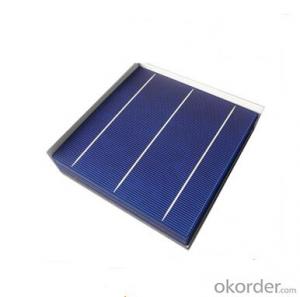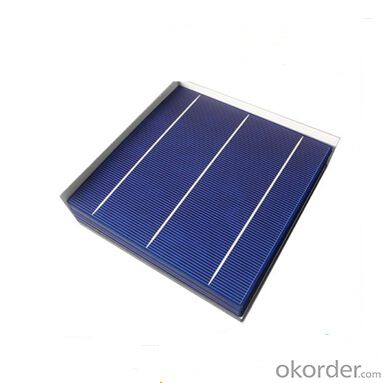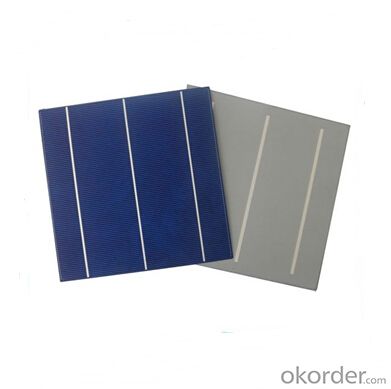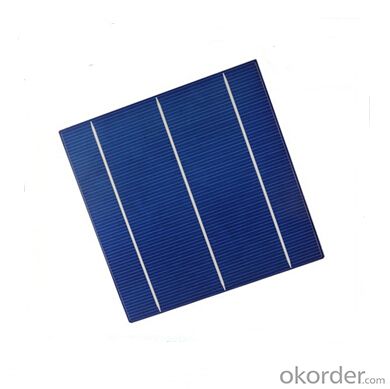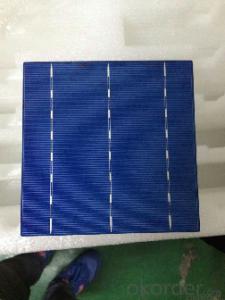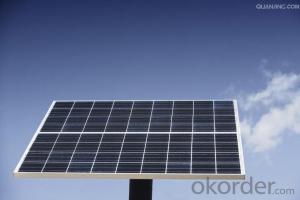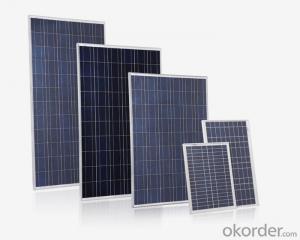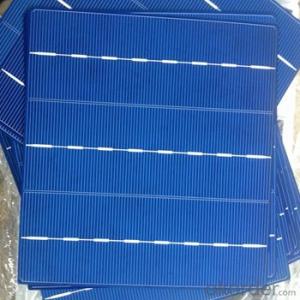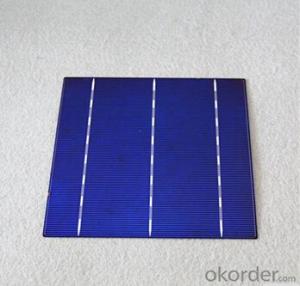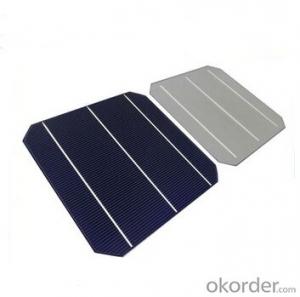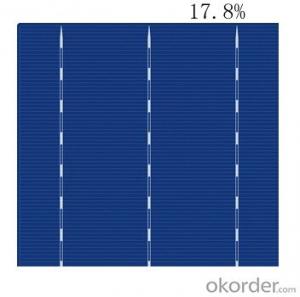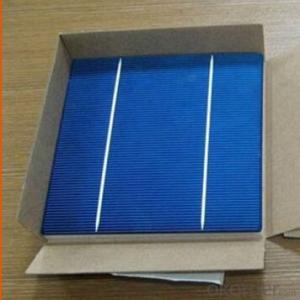Aerospace Grade Polycrystalline Solar Cells - High Efficiency, Low Price
- Loading Port:
- Shanghai
- Payment Terms:
- TT or LC
- Min Order Qty:
- 5000 pc
- Supply Capability:
- 8000000 pc/month
OKorder Service Pledge
OKorder Financial Service
You Might Also Like
Brief Introduction of Solar Cells
A solar cell, is an electrical device that converts the energy of light directly into electricity by the photovoltaic effect, which is a physical and chemical phenomenon. It is a form of photoelectric cell, defined as a device whose electrical characteristics, such as current, voltage, or resistance, vary when exposed to light. Solar cells are the building blocks of photovoltaic modules, otherwise known as solar panels.
Polycrystalline Silicon Solar Cells Advantage:
• High efficiency and stable performance in photovoltaic conversion.
• Advanced diffusion technique ensuring the homogeneity of energy conversion efficiency of the cell.
• Advanced PECVD film forming, providing a dark blue silicon nitride anti-reflection film of homogenous color and attractive appearance.
• High quality metal paste for back surface and electrode, ensuring good conductivity, high pulling strength and ease of soldering.
• High precision patterning using screen printing, ensuring accurate busbar location for ease with automatic soldering a laser cutting.
Usage of Polycrystalline Solar Cells
Solar cells are often electrically connected and encapsulated as a module. Photovoltaic modules often have a sheet of glass on the front (sun up) side, allowing light to pass while protecting the semiconductor wafers from abrasion and impact due to wind-driven debris, rain, hail, etc. Solar cells are also usually connected in series in modules, creating an additive voltage. Connecting cells in parallel will yield a higher current; our solar cells have passed IEC Certification. With high and stable quality, our cells can greatly improve the performance of Solar Modules.
Specification:
Mechanical data and design |
Format - 156 mm × 156 mm ± 0.5 mm |
Thickness- - 200 μm ± 20 μm |
Front (-) - 1.4 mm bus bars (silver),blue anti-reflection coating (silicon nitride) |
Back (+) - 2 mm wide soldering pads (silver) back surface field (aluminium) |
Temperature Coefficient of Cells |
Voc. Temp .coef.%/K -0.364%/K |
Isc . Temp .coef.%/K +0.077%/K |
Pm. Temp. coef.%/K -0.368%/K |
Polycrystalline 156x156mm 3BB | ||||||
EFF Code | EFF. (%) | Pmax(W) | Impp(A) | Vmpp(V) | Isc(A) | Voc(V) |
1760 | 17.60 | 4.28 | 8.060 | 0.531 | 8.610 | 0.633 |
1740 | 17.40 | 4.23 | 8.030 | 0.524 | 8.570 | 0.632 |
1720 | 17.20 | 4.19 | 8.000 | 0.522 | 8.510 | 0.631 |
1700 | 17.00 | 4.14 | 7.850 | 0.521 | 8.490 | 0.622 |
1680 | 16.80 | 4.09 | 7.770 | 0.521 | 8.390 | 0.620 |
1660 | 16.60 | 4.04 | 7.650 | 0.519 | 8.350 | 0.615 |
1640 | 16.40 | 3.99 | 7.580 | 0.516 | 8.290 | 0.615 |
Intensity Dependence |
Intensity [W/m2] Isc× [mA] Voc× [mV] Pmpp |
1000 1.00 1.000 1.00 |
900 0.90 1.000 0.90 |
800 0.80 0.99 0.80 |
500 0.50 0.96 0.49 |
300 0.30 0.93 0.29 |
200 0.20 0.92 0.19 |
IV Curve

Solar Panel Images:
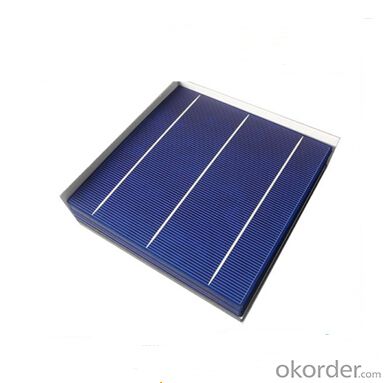
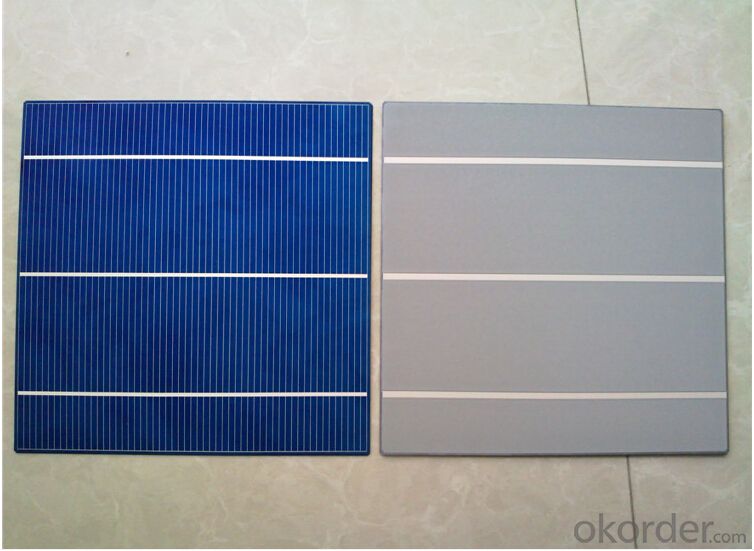
Packaging & Delivery of Polycrystalline Solar Cells
Carton Box Package and Deliver by air. It should be noticed that it should be avoid of water, sunshine and moist.
Faq
We have organized several common questions for our clients,may help you sincerely:
1. What’s price per watt?
A: It’s depends on the quantity, delivery date and payment terms of the order. We can talk further about the detail price issue. Our products is high quality with lower price level.
2. Can you tell me the parameter of your solar cells?
We have different series of cells with different power output, both from c-si to a-si. Please take our specification sheet for your reference.
3. How do you pack your products?
We have rich experience on how to pack the panels to make sure the safety on shipment when it arrives at the destination.
4. Can you do OEM for us?
Yes, we can.
5. How long can we receive the product after purchase?
In the purchase of product within three working days, We will arrange the factory delivery as soon as possible. The perfect time of receiving is related to the state and position of customers. Commonly 7 to 10 working days can be served.
Silicon is the ideal material for solar cells, which is the silicon-based solar cells the main reason. But with the development of new materials and related technologies continue to develop, with other material-based solar cells are also showing more and more attractive prospect.
N-type Crystalline Solar Cell
In the bottom plate of the N-type semiconductor solar cell, a greater resistance to impurities, easier to improve the energy conversion efficiency, in theory, the attenuation rate is relatively low, but the process is more complex and costly. Pentavalent element incorporated in pure silicon crystal (such as phosphorus, arsenic, antimony, etc.), so as to replace the position of the crystal lattice of silicon atoms to form a N-type semiconductor.
At present, has reached large-scale production of N-type silicon solar cells, there are three, namely, Japan's Matsushita N-SiHITN type silicon solar cells, the United States SunpowerIBC structure N-type silicon solar cells, as well as Yingli Panda N-type silicon cells. In market share, the International Technology Roadmap for PV (ITRPV) Expected N-type Crystalline Solar Cell from 2014 up to 18% in 2020 to 50% left and right.
N-type Crystalline Solar Cell industry level: 21% -24%
P- type Crystalline Solar Cell
In the bottom of the P-type semiconductor solar cells, low cost, high attenuation rate, 25 years after the decay rate can reach 15-20%. Incorporation of trivalent elements (such as boron) in pure silicon crystal, so that the position of substitution of silicon atoms in the lattice to form P-type semiconductor.
Industrialization Level - Domestic: 18.7% -19.2% overseas: 19.2% -20%
Battery Polycrystalline
Polycrystalline silicon solar cells combines the high conversion efficiency monocrystalline silicon cells and preparation of amorphous silicon thin film materials as well as long-life battery, etc. relatively simplified new generation of batteries, the conversion efficiency is generally about 12%, slightly lower than the silicon solar cells, there is no obvious efficiency recession, and may be prepared on an inexpensive substrate material, the cost is much lower than silicon cells, and more efficient than amorphous silicon thin film batteries.
Industry level: 17% -17.5%
- Q: How long is the long cycle solar cell life?
- There are discharge depth, such as each time the actual capacity of the battery only 30% of the battery, you can cycle more than 1500 times, that is, 4 years or so, but if every 80%, then only more than a year, 100% It is about 1 year it
- Q: Can solar cells be used for powering manufacturing facilities?
- Yes, solar cells can be used to power manufacturing facilities. By installing a solar panel system, manufacturing facilities can generate renewable and clean energy to meet their power needs. This not only reduces their dependence on fossil fuels but also helps in reducing their carbon footprint and overall environmental impact.
- Q: What are the advantages and disadvantages of solar panels and diodes?
- In the normal power supply when the diode reverse bias; only when the power reverse, the diode is biased conduction, then the diode will be short circuit after the class, and then avoid the negative voltage damage after the circuit
- Q: What is the impact of fire hazards on solar cells?
- The impact of fire hazards on solar cells can be significant and detrimental. Fires can cause direct damage to the cells, resulting in their complete destruction or impaired performance. The high temperatures and flames associated with fires can melt or warp the delicate components of solar cells, rendering them useless. Additionally, the smoke and ash produced by fires can settle on the surface of the solar panels, reducing their efficiency by blocking sunlight. Therefore, fire hazards pose a significant risk to the functionality and longevity of solar cells.
- Q: What is the difference between a monocrystalline and polycrystalline solar cell?
- The main difference between a monocrystalline and polycrystalline solar cell lies in the structure of the silicon material used. Monocrystalline solar cells are made from a single crystal structure, resulting in a uniform and consistent appearance with a high level of efficiency. On the other hand, polycrystalline solar cells are made from multiple crystal structures, giving them a fragmented and non-uniform appearance with a slightly lower efficiency. Overall, monocrystalline cells tend to be more expensive but offer higher efficiency, while polycrystalline cells are more affordable but slightly less efficient.
- Q: Can solar cells be used on mobile devices?
- Yes, solar cells can be used on mobile devices. There are already various portable solar chargers available in the market that can be connected to mobile devices to generate and store energy from sunlight. Additionally, there are also some mobile devices that come with built-in solar panels to directly convert solar energy into power for charging.
- Q: Where can I find more information about the work process of solar cells
- From your teachers at school.
- Q: Can solar cells be used in clothing?
- Yes, solar cells can be used in clothing.
- Q: How can I calculate the cost of using solar cells if I put a fully-functional solar system in my house?
- On average the total cost of solar installation can be between $15,000 to $29,000 for systems sized between 4kW and 8kW.2
- Q: Can solar cells be used for powering electric vehicles in motion?
- Yes, solar cells can be used for powering electric vehicles in motion.
Send your message to us
Aerospace Grade Polycrystalline Solar Cells - High Efficiency, Low Price
- Loading Port:
- Shanghai
- Payment Terms:
- TT or LC
- Min Order Qty:
- 5000 pc
- Supply Capability:
- 8000000 pc/month
OKorder Service Pledge
OKorder Financial Service
Similar products
Hot products
Hot Searches
Related keywords
